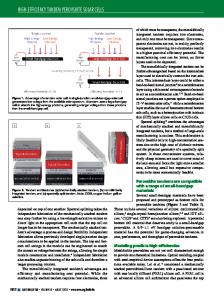Photon recycling in halide perovskite solar cells for higher efficiencies
- PDF / 1,866,626 Bytes
- 10 Pages / 585 x 783 pts Page_size
- 76 Downloads / 337 Views
Introduction Halide perovskite solar cells (HPSCs) have attracted enormous interest because of their great potential as future photovoltaic devices. This is attributed to high-power-conversion efficiency (PCE) and low-temperature solution processes that enable low production cost, mechanical flexibility, and low weight. In particular, attention has been given to HPSCs owing to the unprecedented rapid improvement in their PCE over the last few years. The PCE of HPSCs reached 25.2% in 2019, which is a level similar to that of single-crystalline Si (c-Si) solar cells.1,2 For this reason, the direction of research on HPSCs is shifting from improvements in PCE to commercialization issues, such as long-term stability, scale-up processes, and modularization. However, considering the power-conversion rate per unit area of an installed solar cell, it is a constant challenge to obtain a PCE that approaches the Shockley–Queisser (S–Q) limit for all types of solar cells. Single-junction solar cells, single-crystalline gallium arsenide (GaAs), and c-Si solar cells have achieved PCE exceeding 25%, that is 75% of the S–Q limit. Recently, HPSCs were the third material class to reach a PCE of 25%, after GaAs and c-Si solar cells, and the first to reach it using a polycrystalline film. GaAs and c-Si solar cells have been stuck at the 25% efficiency level for approximately 10 years, which means
a breakthrough at this level is required for the next phase of development. Therefore, the next breakthrough step for HPSCs that have reached the 25% efficiency level must be discussed to set the most suitable directions for development. Unlike the hundred micrometer thick light absorbing layer of c-Si solar cells owing to the indirect bandgap of silicon, HPSCs with a sufficient absorption coefficient need only a thin-film (several hundred nanometers thick) light absorbing layer, similar to GaAs solar cells that have a direct bandgap. Thus, we expect to find one direction for reaching the S–Q limit for HPSCs in the history of the development of GaAs. GaAs solar cells have already achieved a PCE of 29.1%, which is the highest for single-junction solar cells.2 It is notable that photon recycling (PR) is the critical technology that has made GaAs solar cells achieve a PCE that is closest to the theoretical marginal efficiency.3 However, we must consider the structural and material differences between GaAs solar cells and HPSCs to follow the history of GaAs solar cells and to forge a path for HPSCs. In this article, we review the breakthrough technologies that have led to achieving state-of-the-art efficiency of HPSCs in the last few years. We further consider photon recycling (PR) as a technology for the next phase of approaching the S–Q limit level of HPSCs. Although PR has been demonstrated in GaAs solar cells, it remains uncertain whether PR
Seungmin Lee, School of Civil, Environmental and Architectural Engineering, Korea University, South Korea; [email protected] Kwang Choi, School of Civil, Environmental and Architectural Engineering, Ko
Data Loading...










